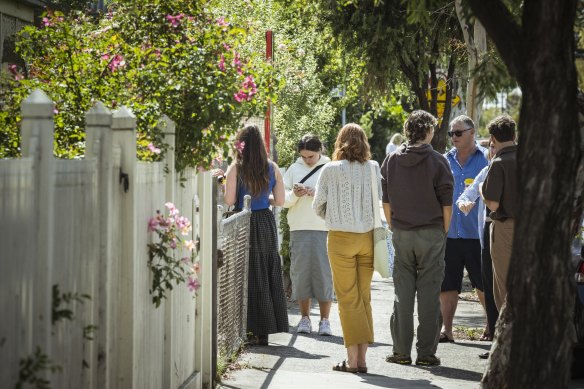Tenants crushed by skyrocketing rents and the cost of living crisis are moving in with more housemates to save money, new figures suggest.
But experts warn that the increased demand for shared housing not only risks the autonomy of single renters, it also puts pressure on families who struggle to compete with multi-income households when applying for larger properties.
Rents for larger houses are picking up, while rents for one-bedroom units are decelerating, CoreLogic figures show.
Rents for five-bedroom-plus houses rose 8.7 per cent over the year to June. It marks a clear acceleration from September last year when rents for large houses were rising at an annual pace of only 5.7 per cent.
Rents for larger houses also rose faster than houses overall (8.4 per cent), houses and units of any other size, and particularly smaller homes such as two-bedroom houses (7.6 per cent and losing steam) and one-bedroom units (7.1 per cent).
One-bedroom units were rising at more than 16 per cent annually in autumn last year, around the same time as former Reserve Bank governor said one way to deal with high rents was to get an extra housemate. As well as cost of living pressures, the slowdown in small units coincided with shifts in net overseas migration - international students may choose to live in smaller homes.
CoreLogic head of Australian research Eliza Owen said although the data does not measure changes in household size, the pick-up in growth for larger homes could be a reaction to the deteriorating affordability of smaller homes.
“Even though larger rental properties are more expensive overall they are cheaper by bedroom, so this is about scaling rental costs by targeting larger properties,” she said.
Rents have jumped more than 30 per cent since the pandemic began, she said, as a rise in housing demand outpaced the supply of homes available.
“That can range from anywhere between a slight discomfort or slight tweaking to their household budget or it can range to an absolutely critical situation where you can’t actually afford a rental property to yourself.
“So some tenants may not have an option but to look for shared accommodation.”
She said rents are rising alongside other essentials like energy, fuel and groceries, so it made sense there would be some reaction in housing demand.
Tenants would pay $175 in average weekly rent per bedroom in a five-bedroom house nationally, CoreLogic found.
This is cheaper than each room in a two-bedroom house ($271 a week) or a one-bedroom unit ($541 a week).
She added that people are renting longer as home ownership rates fall, meaning some tenants are stuck in the rental market but are beyond the share housing stage of life.
“Sharing can be good in the sense of scaling costs, having community, reducing risk of isolation and loneliness but it also comes with a lot of risk, it reduces autonomy of your space and it’s unregulated,” she said.
“We really should have a housing system that gives people the option to live independently.”
Better Renting campaign and project officer Sabrina Clarke said share housing can be a positive experience that creates community - but it can also be difficult.

Tenants are under pressure from rising rents.Credit: Chris Hopkins
She said four and five-bedroom houses used to be in demand mostly from families, but now she sees more multi-income households.
“You might have a share house of four people that all have full-time jobs that families on single or dual incomes are having to compete [with],” she said.
“For families this has been really difficult. We are seeing a trend to more families in housing insecurity, being worried about homelessness.”
Housemates in larger households can also face challenges because they don’t always have control over who they live with, especially if they have to move quickly, she said.
“Share housing used to be something renters could do to be thrifty if you wanted to,” she said.
“But now share housing has become such a necessity for so many people - it’s the only way they can afford to live... which means if you can’t afford to share a house you don’t have a fallback option.”
AMP chief economist Shane Oliver said there were signs that strong rental growth of recent years was starting to cool, which could be explained by tenants adjusting their living situations based on what they could afford.
“More young people think, ‘I’m going to stay at home for longer, this is ridiculous paying this amount of rent,’ or if they move out they move into more shared accommodation,” he said.
“Through the pandemic the number of people per household fell, where there was less sharing. Now you get the impression it’s starting to go back the other way.”
Some young people were moving back in with family, while open home queues had shortened.